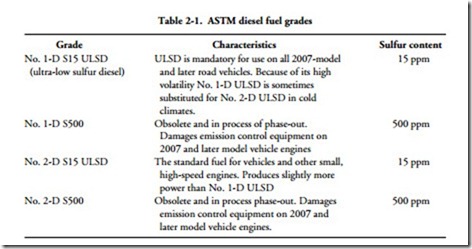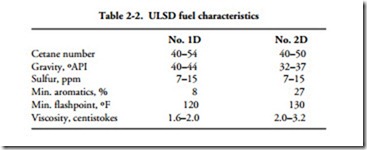Conventional fuels
Diesel fuel is a middle distillate, slightly heavier than kerosene or jet fuel. Composition varies with the source crude, the refining processes used, the additive mix, and the regulatory climate. ASTM (American Society for Testing Materials) norms for Nos. 1-D and 2-D fuels in the United States are shown in Table 2-1.
Table 2-2 lists characteristics the EPA considers typical for Nos. 1-D and 2-D ULSD sold outside of California, which has its own, more rigorous rules. Note that EPA reg- ulations apply only to sulfur content and to cetane number/aromatic content. Other
fuel qualities, such as lubricity, filterability, and viscosity, are left to the discretion of the refiner. As a general rule, large truck stops provide the best, most consistent fuel.
• Cetane number (CN) and aromatic content refer to the ignition quality of the fuel. U.S. regulations permit 40 CN fuel if the aromatic content does not exceed 35%. In Europe diesel fuel must have a CN of at least 51. Aromatic content expresses the ignition quality of the fuel. High-octane fuels, such as aviation gasoline, have low CNs and barely support diesel combustion. Conversely, ether and amyl nitrate, which detonate violently in SI engines, are widely used as diesel starting fluids.
• API (American Petroleum Institute) gravity is an index of fuel density and, by extension, its caloric value. Heavier fuels produce more energy per injected volume.
• Viscosity also affects performance. Less viscous fuels atomize better and produce less exhaust smoke. But extremely light fuel upsets calibration by leaking past pump plungers. Thick, highly viscous fuels increase delivery pressures and pumping loads.
• Flash point, or the temperature at which the fuel releases ignitable vapors, is a safety consideration.

